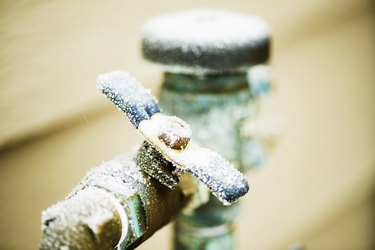Avoiding Frozen Pipes: Effective Tips for Winter
Avoiding Frozen Pipes: Effective Tips for Winter
Blog Article
Everyone will have their own individual idea when it comes to How to Prevent Your Pipes From Freezing.

Winter can ruin your pipes, particularly by freezing pipes. Right here's how to stop it from happening and what to do if it does.
Introduction
As temperature levels drop, the risk of frozen pipes boosts, possibly leading to costly repair work and water damage. Recognizing exactly how to stop frozen pipelines is crucial for homeowners in cold climates.
Avoidance Tips
Insulating at risk pipelines
Cover pipelines in insulation sleeves or use warmth tape to shield them from freezing temperature levels. Concentrate on pipelines in unheated or outside locations of the home.
Heating strategies
Maintain interior areas sufficiently warmed, especially areas with pipes. Open up cabinet doors to allow warm air to distribute around pipelines under sinks.
Just how to identify icy pipes
Try to find reduced water circulation from taps, uncommon smells or sounds from pipelines, and noticeable frost on subjected pipelines.
Long-Term Solutions
Architectural changes
Take into consideration rerouting pipelines far from exterior walls or unheated areas. Include added insulation to attic rooms, basements, and crawl spaces.
Upgrading insulation
Invest in high-quality insulation for pipelines, attic rooms, and walls. Proper insulation assists keep regular temperatures and reduces the danger of frozen pipes.
Protecting Outside Plumbing
Garden hoses and outside taps
Separate and drain pipes yard pipes prior to winter months. Mount frost-proof faucets or cover outside taps with insulated caps.
Understanding Icy Pipelines
What triggers pipelines to freeze?
Pipes freeze when subjected to temperature levels below 32 ° F (0 ° C) for extended periods. As water inside the pipes ices up, it increases, taxing the pipeline walls and potentially causing them to break.
Threats and damages
Frozen pipelines can lead to water disruptions, residential property damage, and costly repair work. Burst pipes can flood homes and trigger substantial structural damage.
Signs of Frozen Piping
Recognizing icy pipelines early can avoid them from bursting.
What to Do If Your Pipelines Freeze
Immediate activities to take
If you believe frozen pipes, maintain faucets open up to eliminate stress as the ice melts. Utilize a hairdryer or towels soaked in warm water to thaw pipes gradually.
Final thought
Preventing icy pipelines needs aggressive actions and fast reactions. By recognizing the causes, signs, and preventive measures, house owners can shield their plumbing during cold weather.
Helpful Tips to Prevent Frozen Pipes this Winter
UNDERSTANDING THE BASICS: WHY PIPES FREEZE AND WHY IT’S A PROBLEM
Water freezing inside pipes is common during the winter months, but understanding why pipes freeze, and the potential problems it can cause is crucial in preventing such incidents. This section will delve into the basics of why pipes freeze and the associated problems that may arise.
THE SCIENCE BEHIND FROZEN PIPES
When water reaches freezing temperatures, it undergoes a physical transformation and solidifies into ice. This expansion of water as it freezes is the primary reason pipes can burst. As the water inside the pipe freezes, it expands, creating immense pressure on the walls. If the pressure becomes too great, the pipe can crack or rupture, leading to leaks and water damage.
FACTORS THAT CONTRIBUTE TO PIPE FREEZING
Low Temperatures: Extremely cold weather, especially below freezing, increases the risk of pipes freezing. Uninsulated or Poorly Insulated Pipes: Pipes located in unheated areas, such as basements, crawl spaces, or attics, are more prone to freezing. Insufficient insulation or lack of insulation altogether exacerbates the problem. Exterior Wall Exposure: Pipes running along exterior walls are susceptible to freezing as they encounter colder temperatures outside. Lack of Heating or Temperature Regulation: Inadequate heating or inconsistent temperature control in your home can contribute to frozen pipes. PROBLEMS CAUSED BY FROZEN PIPES
- Pipe Bursting: As mentioned earlier, the expansion of water as it freezes can cause pipes to burst, resulting in significant water damage.
- Water Damage: When pipes burst, it can lead to flooding and water damage to your property, including walls, ceilings, flooring, and personal belongings.
- Structural Damage: Prolonged exposure to water from burst pipes can compromise the structural integrity of your home, leading to costly repairs.
- Mold and Mildew Growth: Excess moisture from water damage can create a favorable environment for mold and mildew growth, posing health risks to occupants.
- Disrupted Water Supply: Frozen pipes can also result in a complete or partial loss of water supply until the issue is resolved.
WHY CERTAIN PIPES ARE MORE PRONE TO FREEZING
- Location: Pipes located in unheated or poorly insulated areas, such as basements, crawl spaces, attics, or exterior walls, are at higher risk of freezing.
- Exterior Pipes: Outdoor pipes, such as those used for irrigation or exposed plumbing, are particularly vulnerable to freezing as they are directly exposed to the elements.
- Supply Lines: Pipes that carry water from the main water supply into your home, including the main water line, are critical to protect as freezing in these lines can affect your entire plumbing system.
- Underground Pipes: Pipes buried underground, such as those connected to sprinkler systems or outdoor faucets, can be susceptible to freezing if not properly insulated.
https://busybusy.com/blog/helpful-tips-to-prevent-frozen-pipes-this-winter/

As a keen person who reads on 6 Ways to Prevent Frozen Pipes, I was thinking sharing that article post was a good thing. Do you know about somebody who is fascinated about Helpful Tips to Prevent Frozen Pipes this Winter? Please feel free to share it. Thanks a lot for being here. Revisit us soon.
Call Today Report this page